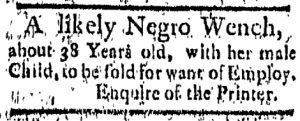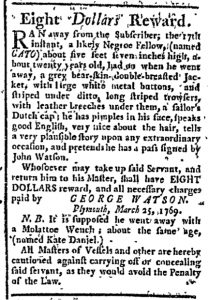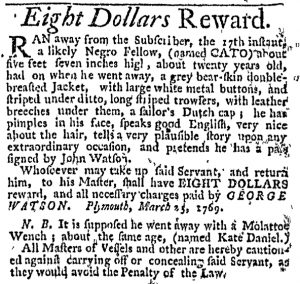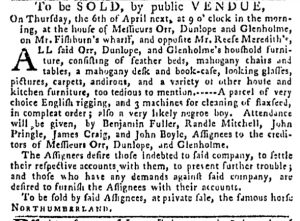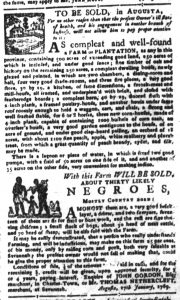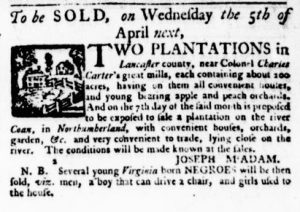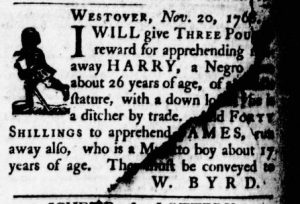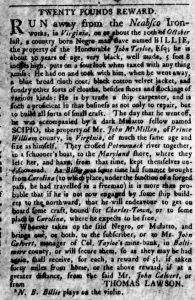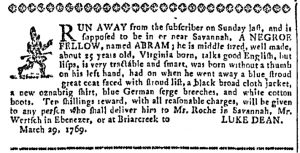GUEST CURATOR: Aidan Griffin
What was advertised in a colonial American newspaper 250 years ago today?

“Mulberry Trees, to the Number of Three-Thousand, to be sold at a reasonable Rate.”
If you know anything about the weather in New England, it might seem not that strange that William Hanks advertised mulberry trees in late March 1769. However, what surprised me was that these trees were used for silk production because silkworms love mulberry leaves. Attempts at silk production in America goes back really far. According to Bob Wyss, “Silkworms were first imported to Virginia as early as 1613.” Producing silk in Virginia makes sense as it is warmer there, but why in Connecticut? “In 1734 the Connecticut Colonial Assembly passed legislation offering financial incentives for silk growers.” Now this might seem difficult, but two people actually succeeded. “One was Nathaniel Aspinwall, a horticulturalist. In the 1750s Aspinwall planted mulberry trees at a nursery he owned in Long Island and later in Mansfield and New Haven, Connecticut. Aspinwall also raised and distributed to customers the silkworm eggs needed to produce the caterpillars and cocoons. The second individual was Ezra Stiles, president of Yale College, who kept a diary of his silk-raising activities from 1763 to 1790.” Soon, this interest in silk production turned into full-blown mania when prices for mulberry trees kept rising and rising. The mania ended in the early nineteenth century when the prices crashed. In such bitter irony, the crash hurt Connecticut the most. “No place was struck harder than Connecticut,” Wyss explains.
**********
ADDITIONAL COMMENTARY: Carl Robert Keyes
William Hanks’s advertisement for “Mulberry Trees … sold cheap for the speedy promoting the Culture of SILK” in Connecticut appeared on the same page as the “COUNTRY NEWS,” snippets of news from around the colony that supplemented letters to the editor and news from other places in North America and beyond. The “COUNTRY NEWS” also promoted silk production, noting the recent efforts of Hanks and others. In the previous year, the New-London Gazette reported, Hanks “raised Silk sufficient to make Three Women’s Gowns.” In addition, “Sundry Gentlemen in Windham and Lebanon have large Nurseries, and others Orchards of Mulberry Trees, which have been cultivated to bring on a Silk Manufactory.” Furthermore, “One Silk House is already erected in Lebanon.”
The “COUNTRY NEWS” did not, however, focus exclusively on silk. The printer inserted updates about vineyards as well, briefly noting that a “Gentleman in Windham is also cultivating a large Vineyard.” This section of the newspaper included an even longer overview of another colonist’s attempt to establish a local vineyard. That colonist was none other than William Hanks. “We are informed,” the New-London Gazette proclaimed, “that Mr. William Hanks of Mansfield, in this Colony, is now cultivating a large Vineyard; and as the Vines at present look very Promising, he hopes to be able in Two or Three Years to furnish the Public with Wines unadulterated with any Duties.”
The newspaper’s correspondent for that bit of news was probably none other than William Hanks himself. He likely submitted that information to the printing office at the same time as the copy for his advertisement. He then benefited from its appearance (along with the assertion that he had produced enough silk for three gowns) as a news item, one that simultaneously served as a puff piece that promoted the mulberry trees he advertised elsewhere in the newspaper. The final phrase in the report about his vineyard further enhanced Hanks’s marketing by giving it a political valence. In stressing that Hanks’s wine would be “unadulterated with any Duties,” the newspaper advanced “Buy American” sentiments consistent with calls to produce more goods in the colonies in order to correct a trade imbalance with Britain and to consume those goods as acts of resistance to the Townshend Acts and other abuses by Parliament. Readers of the New-London Gazette encountered this message in both the news and the advertisements as they moved from “Wines unadulterated with any Duties” in the “COUNTRY NEWS” to “Mulberry Trees … for the speedy promoting the Culture of SILK” among the paid notices.


